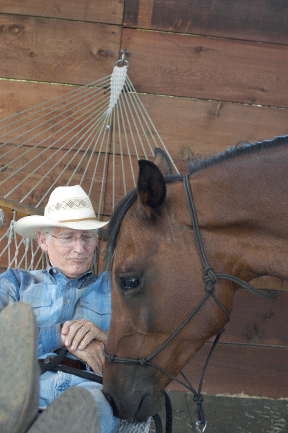I remember that it was an unusually chilly day for late May, because I recall the jacket I was wearing. Not so much the jacket, I suppose, as the collar. The hairs on the back of my neck were standing at full attention, and the collar was scratching at them.

There was no one else around—just me and this 1,100-pound creature I’d only met once before. But there was something about him. A kindness in his eyes. I wanted him to be more than chattel. I wanted a relationship with this horse.
But it would be his choice, not mine. I turned my back and stood there, shoulders slumped, trying desperately to appear relaxed, trusting—everything the book had told me to do. I waited for his decision, my heart pounding. The seconds seemed like hours. Then, a puff of warm, moist air brushed my ear. My heart skipped a beat. He was really close. Then his nose was on my shoulder. I couldn’t believe it. Tears came out of nowhere and streamed down my cheeks.
From that moment I knew I had to do right by this horse. He had said I trust you and no longer could it be what I wanted, but rather what he needed—what 55 million years of genetics demanded for his long, healthy, and happy life. And that decision has made all the difference.
I’m still astonished when I think where my wife Kathleen and I began. We’ve been with horses less than three years, but they’ve been a compulsive, obsessive three years. I figured as old as I am, I’d better get up to speed fast. And we were starting from scratch, complete neophytes stumbling and bumbling our way into this enigmatic world of horses without so much as a clue. It was a time of mistakes, fear, fascination, and frustration—and ultimately the discovery that something was very wrong in this world of horses. Either that, or we had lost our minds.
Our journey became my new book, The Soul of a Horse, and it all began right here in Horse&Rider. A subscription was my first purchase…well, after the horses. Kathleen likes to point out how backward that was.
There were so many questions. Cash, a 9-year-old, unregistered bay gelding came to us wearing metal shoes on his front feet. His rear feet were barefoot. I was told that bare hooves banging against hard surfaces—be they concrete, asphalt, dirt, or rocks—will cause hoof walls to crack, shatter, and crumble.
“Why doesn’t he have shoes on his back feet?” I asked everybody. But their answers didn’t make any sense.
Then the February ’06 issue of H&R arrived, and in it the article, Is Barefoot Better?, by Jenny Meyer. In this article I learned that I was asking the wrong question. I should’ve been asking why Cash had shoes on any of his feet.
I learned a hoof was supposed to flex. And why. And when a metal shoe was nailed to the hoof, it couldn’t flex. I learned about the wild horse model, which tells us that horses in the wild have rock-crushing hooves which are genetically the same as our domestic horses’. And that wild horses have virtually no lameness. Then, in the last paragraph, Jenny said she would be giving barefoot a try on her horses.
Wow. Someone with experience saying I wasn’t crazy. I liked her from the start.
I scrambled to the Internet and bought books and videos, and in three weeks, all six of our horses were barefoot. Not long after, they had new diets and were out of their stalls day and night, eating off the ground and moving 10 to 12 miles a day.
Once in the soup, I began to question all sorts of other things, and what I found was like a jigsaw puzzle. The picture I was beginning to see more and more clearly was that we humans have completely manipulated horse care and training to suit ourselves, not the horse.
Yet when we take control of a horse’s life, when we say I will be responsible for this animal, his care and feeding, his health and happiness, we tacitly promise to give him the very best care that we can, and the longest and best life possible.
This is the synthesis of The Soul of a Horse, and why it came into being.
The rewards have been an elixir. We’ve learned that nothing can make you feel better than doing something good for another being.
We’ve learned to give the choice of choice to our horses, our employees, our friends, and our loved ones. And it has come back a hundredfold.
We’ve learned to always question everything. To make decisions based upon knowledge, not hearsay. To know that if something doesn’t seem logical, it probably isn’t. And if it doesn’t make sense, it’s probably not right.
Thank you, Jenny, for the kick start.
Cash, Scribbles, Pocket, Mariah, Skeeter, and Mouse thank you as well.






